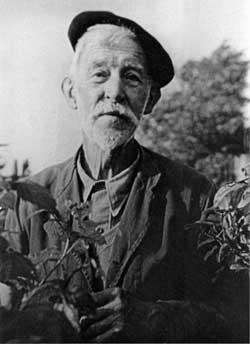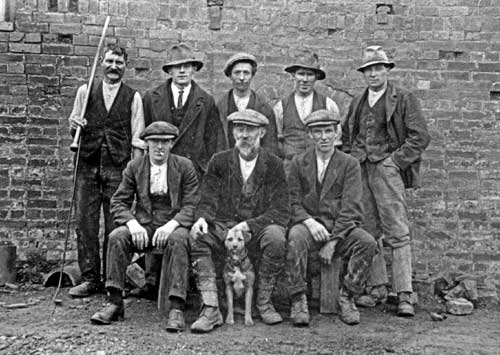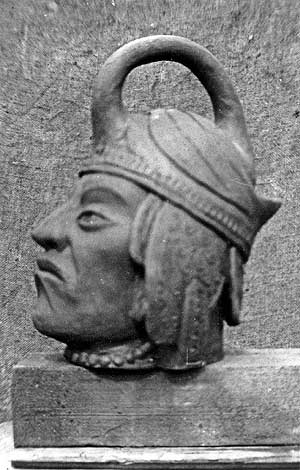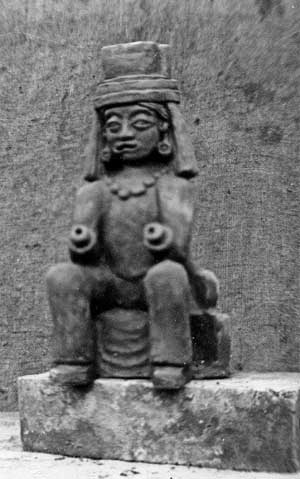
HARRY PRITCHETT ARCHAEOLOGIST AND ARTIST
Posted by Admin on 26 October 2011, 11:52 am
ARCHAEOLOGIST AND ARTIST
by T. C. Hudson
Image Harry Pritchett c1946
When the contents of a tea-chest were ruined by the damp environment in which the chest was stored, the whole of Harry Edmund Pritchett’s hand-written literary work was lost forever. Also lost was the result of his genealogical research that appeared to trace his ancestry back to William Pritchett of Worcester (1569) who was the husband of Joan Rufford, whose ancestors began with Sir Kynard De la Bere (1066). From 1569 onwards the family tree contained many noteworthy people including John Pritchett, Captain of Richard’s castle (1641); the Rev. George Pritchett, B.A. Oxon, Vicar of Mathon, Worcestershire (1794-1835); the Rev. Delabere Pritchett, Vicar of Carew, Pembroke, and Sub-Chantor of St David’s Cathedral, who died in 1801; and the Rev. Richard Pritchett, B.D., Fellow of St John’s, Cambridge, and Rector of Layham, Suffolk, born 1743, died 1811. Of special interest was a mention of Elizabeth, daughter of Sir John Huddleston by Jane Seymour – an aunt of the wife of Henry the Eighth. Elizabeth was the wife of one of the De la Bere family – another Kynard.
The remaining manuscripts could be divided into four classes – Poetry, Stories, Archaeological Notes, and Major Works on the same subject. Of fifty poems, many were unpretentious verses expressing homespun philosophy; some attempted to capture scenic beauty; others praised heroic figures. When humour was essayed, it was heavy-handed. There were, too, several religious themes. These, and some of the others, reflect the poet’s character – his simple faith and sterling moral qualities. Generally speaking, however, the poems lacked polish and, although rhymed, evinced a disregard for the rules of prosody, failing adequately to express the emotions he so obviously felt.
His stories, too, of which there were thirty, some extending to eight thousand words, although the work of a born story-teller, again betrayed the untrained amateur – his style, leisurely and over-florid, belonging to an even earlier period than the early ‘Thirties in which they were written – readable but unmarketable. Based on Isle of Wight legends, they carried dramatic titles – ‘The Phantom Huntsman’; ‘The Brand of the Cloven Hoof’; ‘The Blood Token’; and ‘Beric, Socman of Gedda’s Hill’, the last overweight with erudition. Another tale, ‘Lot’s Wife’, in which Josiah Wedgwood and his wife come to inspect the coloured sands of Alum Bay, contains examples of the now seldom heard I.W. dialect. This one probably a tribute from a fellow potter; for Harry Pritchett himself was noted for his expertise in modelling clay, a medium in which, having a strong feeling for the grotesque, he sculpted effective gargoyles. Much of his work was inspired by ancient civilisations, particularly by the Aztecs and Egyptians, and he specialised in huge vases decorated with coloured clay, using a method known to have been employed when Egypt was under the Pharaohs. A water colour painted for the now closed Industrial Museum shows him putting the finishing touches of colour to an exquisite bust of Queen Nefertiti.
A quiet self-contained man, with his beret and pointed beard (an unusual feature in the ‘Twenties) his appearance and demeanour indicated essentially what he was – an artist and scholar, albeit untrained and to a certain degree untutored. Evidence of his skill as a wood-carver was to be found in the beautifully decorated oak chairs with which as a young man he had furnished his home – furniture whose life-span might be measured by the hundred years. Occasionally his reputation as a craftsman would bring orders for carved items, one in particular being a large overmantel commissioned by someone entitled to display armorial bearings.
When engaged in the graphic arts, Harry Pritchett did most of his work in water-colours. Lost with the rest of the material were pictures of Isle of Wight, Scottish, and Italian scenery, all of which revealed a good eye for colour – a quality even more in evidence in some superbly coloured drawings of celts (prehistoric axe-like instruments) and eoliths (very early roughly broken or naturally formed tools) discovered in Newtown and Northwood – work reminiscent of John Ruskin at his best. In 1930 a seascape depicting a wild day off Atherfield which he entered for an exhibition organised by the newly formed Cowes Art Club, gained press commendation. His limited output of oil-paintings has a hint of classicism that reminded one of Claude.
If the artist’s precise delineation and Ruskinian appreciation of colour subtleties were not enough to reveal his first love to be archaeology, a perusal of his scientific treatises would be. In ‘Vectis: Notes on Stone Age Implements’, for instance, we see the result of countless hours devoted to the discovery and identification of worked flints – pieces of material for which an uninitiated eye would not spare a second glance. Page after page disclose the painstaking detective work involved, and the reader is taught to recognise a manufactured article and by its patination and its situation (although the last named is not an infallible guide) to assess its approximate age.
Numerous sites are mentioned; some of them on account of erosion were constantly yielding fresh treasures. Bowcombe, Briddlesford, Brighstone, Calbourne, Cridmore, Downend, St George’s Down, Knighton Gorges, Loverston, Mark’s Corner, Northwood, Newtown, Ramsden, Rill, Rookley, Sibdown, Sticelett, and Whitcombe – all were inspected and searched; the friable cliffs at Newtown being especially rewarding.
At Chawton (Northwood), where stood a chain of settlements that might well have constituted a primitive metropolis, he found a practically inexhaustible supply of more or less finished tools. At Crocker’s (Crucga’s) Farm, not far from Chawton, although flint-strewn ground made searching an exacting task, some tools considered by him to exhibit the skill of a master craftsman came to light.
It is not until photographs and sketches of pre-historic tools are scrutinised that one really becomes aware of the expertise required to identify them; an unremarkable piece of flint may be a circular scraper or a plano-convex knife. Not all the tools had sharpened edges, and from Crocker’s he retrieved some ‘rather clumsy and ill-finished implements – something to pound with – hefty weapons with many uses, but not objects of symmetry or beauty.’ These had little appeal, so he retained only six.
Much of the text, of course, deals with scientific data relating to the movement of strata and the geological features that govern patination. To the non-student this information affords little of interest, but from time to time the author digresses, and it is then that his imaginative reconstructions delight the ordinary reader. In addition to describing the tool in question, he suggests the use to which it was put. A knife-like instrument, coupled with reeds growing on the banks of the Medina, cause him to reflect that both would be required for thatching huts, basket making, and probably for weaving mats used as clothes. After unsuccessful hours on St George’s Down he found a broken polished celt whose delicate proportions suggested it might have been a surgical instrument or a razor. The size and curve of a cutting edge, he deduced, often indicated its function – a small radius probably indicating it was employed to reduce strips of hide to the diameter needed for bow-strings.
Image: Harry Pritchett (with dog) and his employees at Northwood Brickyard c1925
Experience gained by his association with the Island’s leading brick and tile manufacturers enabled him to write authoritatively on early pottery – a subject associated with his discovery of fire-blackened ‘pot stones’ which he thought were contemporary with Bronze Age cinerary urns. His knowledge told him the urns were only partly fired at a temperature raised by burning grass and brushwood. From this he deduced that kilns were unknown, and no craftsman then had the skill to make a fire-proof cooking utensil. For culinary purposes he suggested basket-work daubed with clay might have been used, or if this were not practicable he thought it likely a mass of loamy clay could have been hollowed in the centre to form a receptacle for water and food.
In these days when even short journeys are done by private or public transport, it is illuminating to read of the miles Harry Pritchett covered on foot when out for a day’s exploration. On one occasion, having arrived at Buck’s Farm, between Kingston and Shorwell, he proceeded to Billingham and from there, via Berry Shute, to Ramsden, Roslin, and Cridmore near which he found a flint tool, but having no permission to pursue his investigations, he again returned to the road where ‘eight miles of steady tramping brought the Norman spire of Carisbrooke within a stone’s throw, and thence down the hill to Newport and home.’ It was during that outing he encountered ‘what must have been the father of all adders’, which barred his passage to Cridmore and raised its head to strike. Fortunately he was able to break its back with his walking-stick. The adder was a yard long, and the incident ‘caused the rest of the ascent to lose much of its charm as it was impossible to scan the ground as one advanced to make sure the fellow’s family was not lying in wait to even the score.’
A photograph taken at the site that rewarded his efforts with a Bronze Age cinerary urn now in Carisbrooke Castle Museum shows he was assisted by Dr P. Gibson of Cowes who liked, when his practice permitted, to exchange his stethoscope for a trowel and sieve. Another colleague with whom he shared his all-absorbing interest was Mr G. A. Sherwin, the curator of Carisbrooke Castle Museum, about whose death in 1943 at the age of 65 Harry Pritchett wrote ‘Local archaeology will lose one of its most distinguished scholars whose intimate knowledge of the Roman period was a valuable asset not only on the Island but beyond’. Also a collaborator was Mr T. Poole of Shanklin, an authority on flints, who undertook to classify and date his specimens – the work done with a view to compiling a companion book to his (Poole’s) ‘Palaeoliths and Gravel Deposits’.
Although all three of Harry’s major works were incomplete, the aforementioned already covered 182 foolscap sheets. His ‘Geological Features of the Isle of Wight’ 185, and ‘Isle of Wight – A History of Local Digs’ had reached 91.
His notes also make fascinating reading material. Beginning with those covering the disclosure of Romano-Belgic remains at Thorness in 1932, and at Bowcombe in 1941-2. The site of the Roman kiln at Thorness had been investigated before, causing him to write of having to obtain permission to re-open it. One can imagine the patience required to unearth, clean, and try to match hundreds of sherds, scarcely any two of which fitted together. Throughout the notes interpolated sketches depicted how significant fragments were interpreted to suggest the shape of the utensil from which they were broken – two pierced handles indicating a vessel originally carried by a leather thong. Oyster shells, the jawbone of a wild boar, Samian sherds – all were diligently examined and weighed as evidence. Iron nails and a door-hinge, giving evidence that iron was fairly common, led to the supposition that iron ore might have been mined and smelted on or near the spot.
Writing of a stone enclosure in a nearby hollow, the author recalls the stagnant water and that it was impossible to guess the stonework’s purpose. The bottom consisted of one slab that may have concealed anything or nothing. The uncertainty intrigued him.
Flint implements, he noted, prove the long chain of succeeding civilisations which singled out this commanding position for a settlement. Waves of Celtic tribes as they flowed westward tarried on high points along the Solent, each leaving traces of its stay. No one could say what the next spadeful would dig up, so the archaeologist must dig and dig again; then at the end of the day plod homeward with the spoils – to spend the evening washing and classifying them, and in reflective mood wonder who fashioned those things, what manner of man he was, what his surroundings, and what his outlook.
In another section, he describes the whole process of pottery making, from the preparation of the clay to the stacking of the as yet unbaked items in the circular kiln.
His notes on the excavations at Bowcombe proved to be a detailed history of ‘digs’ commenced in July 1941, and abandoned when the land changed hands early in 1942. From the opening of the first trench minor successes rewarded their efforts, and a pair of bronze tweezers and a Roman coin came to light together with several matching pieces of pottery decorated with an intricate design. On October 12th he, a man from Rew Street named Flux, and Harry’s grandson Michael were exposed to a boisterous and bitterly cold northerly wind which made them thankful for the shelter afforded by a stand of elms. Their hardihood, however, paid dividends when they brought to the surface ‘the best exhibit yet to be found’ in the form of a bronze harness-ring attached by an ornamental clip to a curved plate that still held the rivets for fixing it to the trappings of a chariot team.
From time to time green stains (the clue to bronze relics) were encountered, but apart from a fragment of a pin only the crumbling remains of some delicate objects could be scraped from the stains. Mixed Samian and black-ware sherds in large quantities were found, including several complete vessel bases.
On November 9th, in a cutting wind, the workers were digging a new opening that at a moderate depth produced pieces of Samian ware, and later the lower half of a large pot which they hoped to remove intact. In this they were disappointed when it proved to have a network of fractures, and had to be marked in chalk and brought out in pieces. The entry for November 23rd recorded that after two weeks of heavy rain work started again in sunny conditions, but underfoot a surface churned up by cattle into treacherous mud made digging a feat of endurance rather than a pleasure: a hard day’s labour giving them a bag of assorted sherds.
At this time something distinctly unusual in the distribution and disparity of levels in contiguous trenches suggested an urn field later converted into a kitchen midden ‘unless our Belgic forerunners had grotesque ideas of sepulture’.
The end of November was noted as ‘a day of penetrating chill and discomfort’ but at its close, after collecting a considerable number of Samian and Belgic potsherds, Harry and his grandson enjoyed their moonlit walk to the Newport bus station.
During the war Harry Pritchett joined the Home Guard in which, no doubt, he applied himself to the defence of his beloved isle with the zeal characteristic of his endeavours to lift the veil on past civilisations.
At the time when the late Mrs Enid Cheek (née Pritchett), Harry Pritchett’s daughter whom I had known since she was twelve, allowed me to examine and sort the contents of the tea chest, she was in good health and therefore had no idea that in the future a severe and terminal illness would make her leave her Newport home unoccupied for a long enough time to destroy her father’s records.
I now wish wholeheartedly that I had taken copies of them and, as I was tempted to do at the time, kept and enjoyed those exquisite water colours for an indefinite period. This I could have done, for I alone knew they existed.
T. C. Hudson
|
|
|
|
|
|
|
|
|
|
|
|
|
|
|
|
|
|
|
|
|
|
|
|
|
|
|
|
Images: Terracotta by Harry Pritchett c1929
Other Articles by Mr T.C. Hudson are listed below, but also see the T. C. Hudson button on the front page of this website to access all poems and articles.
THE SECOND OLDEST PROFESSION? – Brickmaking on the Isle of Wight, Northwood brickmaking and Harry Pritchett.
POTTER’S PLAQUE – A further appreciation of Harry Pritchett’s work.
THE MASS – The story of the restoration of a 1910 Masser Horniman car.
TURNPIKES – Toll roads of the Isle of Wight (19th century)
© T. C. Hudson this article may not be reproduced without prior permission of the author
Village
- - Apollo Theatre
- - Cowes Amateur Operatic and Dramatic Society
- - Cowes Amateur Winemakers
- - Cowes Heritage
- - Cowes Radar Ex-Employees Association (CREEA)
- - Cowes-Deauville Twinning Association
- - Friends of Northwood Cemetery
- - Newport Rowing Club
- - Northwood Floral Art Group
- - Northwood Village Produce Association
- - Northwood W.I.
Parish Council



